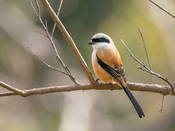search
Мастера на PROFI.RU:
| Ремонт квартир |
| Уборка квартир |
| Мастера по маникюру |
classification:
Gaviiformes
Podicipediformes
Pelecaniformes
Ciconiiformes
Phoenicopteriformes
Anseriformes
Falconiformes
Galliformes
Gruiformes
Charadriiformes
Pterocletiformes
Columbiformes
Cuculiformes
Strigiformes
Caprimulgiformes
Apodiformes
Coraciiformes
Upupiformes
Piciformes
Passeriformes
|
basic information
|
Long-tailed Shrike
Lanius schach (Linnaeus, 1758)

|
 adult
|
|
|
2016-06-17
Atyrau. Victory park. |
© Askar Isabekov
|
|
Description
The Long-tailed Shrike is well distinguished from other Shrikes by the bright, contrast color and the long tail. The adult male has grey crown and nape, grey buffy tinged fore-back, brightly-buff rear-back, rump and uppertail; black forehead, lores and ear coverts. The forming black mask enframes the eyes. Above the eye over the black mask there is faint off-white supercilium. The throat, breast and abdomen are off-white with buffy tinge which is more intensive on the flanks and undertail. The wings are black-brownish. The wing coverts are almost black, primaries are dark-brown with white bases forming the little speculum almost hidden by the wing coverts; the secondaries are dark-brown with buffy edges. The central tail feathers are black-brown, next ones become paler, the outer are pale-brown buffy tinged. All tail feathers except the central pair have pale edges. The adult females are slightly dimmer; the grey on head and nape isn't clear but brownish tinged; the tail and flight feathers are not black but brown. The bill and legs are black-brown, eyes are dark-brown. Sometimes breeding young males (probably second-year) keep the partial juvenile plumage. These birds have some mottled feathers among the other grey on the crown; the secondaries and some wing coverts have pale buffy edges separated from the brown centers by the narrow strips; the dark pre-terminal bands are kept on the feathers of uppertail and breast. Juveniles in first plumage. The crown, nape and fore-back are brownish-grey with brown scaly pattern; the rear-back and uppertail are rusty with brown pattern; the flight feathers are dark-brown with rufous edges. The underparts are grayish with brown scaly pattern. The mask is pale-brown. Sizes: males – wing 90-96.8, tail 121-127; females – wing 91.6, tail 116 mm. Weight 37-42 grams.

Distribution
The Long-tailed Shrike breeds in southern Kazakhstan, in north to Dzhulek settlement in Syrdarya (possibly to Kzyl-Orda); Chulak-Espe; Taraz; and in Tien Shan foothills eastward to Almaty, where appeared in 1955. It is regarded as breeding bird to Kazalinsk. At Suzak obtained July 19 1935. In recent decades it colonised Ile delta (from 1982) and near Alakol lake (1993); breeding birds recorded in 1999 at Karabuta village. Wandering birds have been recorded in Kurgaldzhino Reserve (where female shot in May 31 1987 at Karazhar village), on Northern Ustyurt (at Beyneu station August 12 1989), and in Naurzum Reserve (May 26 2000). June 14, 2016 observed in Victory Park (Atyrau) by Ilkka Sahi (Finland).
Biology
The Long-tailed Shrike is rare breeding migrant. It inhabits agricultural land and open areas with trees, often in or near villages (where also seen on migration), on plains and in foothills up to 1000-1500 m. Arrives late in April to mid of May in singles or pairs. Breeds in separate pairs at 100-150 m one from another. Nest is built in a tree (apricot, poplar, walnut, false acacia, apple tree, elm) of thin twigs and dry grass lined with softer grass and hair, at 5 to 10 m from the ground. Clutch of 4-6 eggs are laid late in May to early June. Both parents feed juveniles, who fledge early July to late August. Lives exclusively on insects, locust in particular. Small birds and reptiles make uncommon prey. Long-tailed shrike can often be seen sitting on wires and looking out for insects on the ground. Autumn migration occurs late in July to early August, last recorded from mid to end of September.
Subspecies
| Lanius schach erythronotus (Vigors, 1831) Description. It distinguished from East Himalayan subspecies tricolor by the absence of black or blackish color on the crown, nape and on the fore-back; and by lighter tone of rusty color on the rear-back. |
References
"Птицы Казахстана" том 3. "Наука". Алма-Ата, 1970.
Gavrilov E. I., Gavrilov A. E. "The Birds of Kazakhstan". Almaty, 2005.
Э.И.Гаврилов. "Фауна и распространение птиц Казахстана". Алматы, 1999.
supplement
subspecies(Vigors, 1831)
synonyms
(Buturlin, 1911)
go to family:












